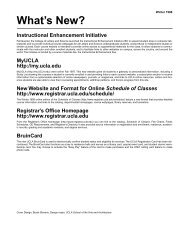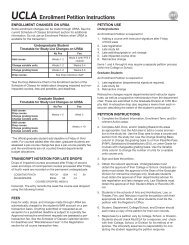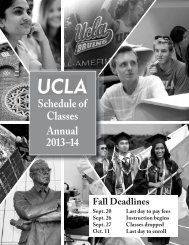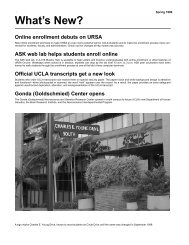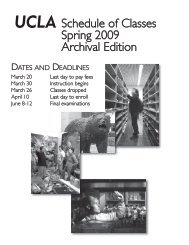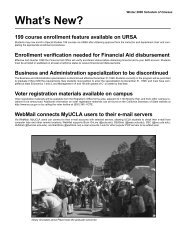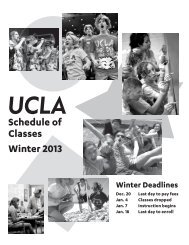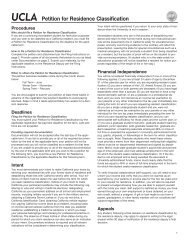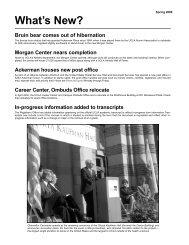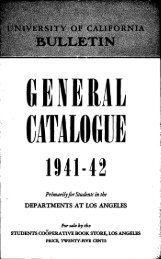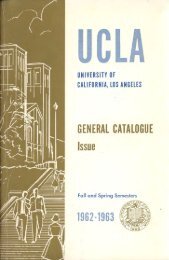UCLA Graduate Catalog 1980-81 - Registrar - UCLA
UCLA Graduate Catalog 1980-81 - Registrar - UCLA
UCLA Graduate Catalog 1980-81 - Registrar - UCLA
Create successful ePaper yourself
Turn your PDF publications into a flip-book with our unique Google optimized e-Paper software.
looked like an ancient Roman<br />
villa dug up at Herculaneum,<br />
because they wanted to.<br />
Even today the houses that<br />
Nathanael West described in Day of<br />
the Locust are to be found in the<br />
Hollywood Hills. Bungalows in<br />
the guise of miniature castles,<br />
Swiss chalets, Tudor houses,<br />
Chinese pagodas, Islamic mosques<br />
- all constructed of two-by-fours<br />
and plaster, and still lived in and<br />
cherished by a new generation<br />
who believe in make-believe and<br />
aren't afraid to be different.<br />
Since the whole city had somewhat<br />
the look of a movie set, it is<br />
not surprising that, back in the<br />
middle 1920s, Westwood Village<br />
was built in the Spanish colonial<br />
style, and <strong>UCLA</strong> began its Westwood<br />
campus on the adjoining<br />
hills with four buildings in the<br />
Romanesque style of medieval<br />
Northern Italy. The place and the<br />
climate were hospitable to any<br />
architectural fancy.<br />
Though high rise and contemporary<br />
design have intruded on<br />
these original conceptions, they<br />
have not been obliterated, and<br />
from one of the new towers to the<br />
south of the village, on Wilshire<br />
Boulevard, one looks down today<br />
on what might loosely be described<br />
as a Romanesque-modern Camelot.<br />
Westwood is of course one of<br />
the great learning centers of the<br />
world, a city within a city, not only<br />
emanating its intellectual energy<br />
to the metropolis that surrounds<br />
it, but also attracting and absorbing<br />
the life and vitality of that<br />
metropolis. In a sense, <strong>UCLA</strong> is the<br />
heart and source of Los Angeles.<br />
It is our well. Its shows, lectures<br />
and concerts draw sellout crowds<br />
from the general community, and<br />
citizens who have no academic<br />
connection with the University<br />
will find excuses to enjoy its<br />
beautiful trees, greens, walks and<br />
gardens and mingle with its<br />
beautiful people. The village, with<br />
its cluster of first-run movie<br />
theaters, its good small shops and<br />
restaurants and its exhilarating<br />
mix of students, faculty and<br />
townspeople, has become the<br />
most popular rendezvous and<br />
walking place in Los Angeles.<br />
Campus and village, in turn,<br />
are enclosed like the pearl of an<br />
oyster in a community of enormous<br />
wealth, vitality and good<br />
humor. In nearby Bel-Air, Pacific<br />
Palisades and Beverly Hills, one<br />
might drive for days without<br />
passing a house worth less than<br />
half a million dollars, and few<br />
would be that cheap. They would<br />
be English cottages, French<br />
Chateaux, Spanish castles,<br />
colonial mansions, Georgian<br />
country houses, Egyptian temples<br />
- side by side in a sort of<br />
insouciant harmony. And living<br />
in them, among the nabobs and<br />
philistines, would be one of the<br />
highest concentrations of creative<br />
people in the world, living the<br />
bountiful Los Angeles life with<br />
their maids and Alfa Romeos and<br />
swimming pools and Afghan<br />
hounds and of course their<br />
amusing hangups.<br />
Critics have despised us in Los<br />
Angeles as worshippers of money,<br />
health, sex, surf and sun. Not<br />
quite true. We don't worship those<br />
things; we just rather get used to<br />
them, since they happen to be so<br />
available. We also love education,<br />
music, the theater, football, auto<br />
racing, ballet, skiing, tennis,<br />
good food, good wine and casual<br />
clothing, and we take them for<br />
granted, because they are here,<br />
along with our magnificent<br />
beaches, from Laguna to Malibu,<br />
our visible mountains, our nearby<br />
deserts, our museums, our<br />
galleries and our spring weather,<br />
which comes in January and lasts<br />
through November.<br />
There is a visible Los Angeles.<br />
It may be seen in some of the<br />
most imaginative and beautiful<br />
churches, shopping centers,<br />
colleges and public buildings in<br />
America, in our freeways, which<br />
move traffic better than those of<br />
any other large American city, and<br />
are nothing less than works of art,<br />
among the modern wonders of the<br />
world; in our stadiums and palms<br />
and eucalyptus trees and our lilac<br />
foothills; in our mansions and our<br />
houses with yards, in our boulevards<br />
and marinas, and in our<br />
"big dumb ocean," as an Eastern<br />
critic once strangely described it.<br />
But the Los Angeles that makes<br />
us stay here, including the critics,<br />
who rarely go home again after<br />
their second visit, is invisible.<br />
It is space, newness, openness,<br />
tolerance, energy, optimism and<br />
exuberance, and the probable<br />
truth that, as Will Rogers said,<br />
we are all a little bit cuckoo.<br />
Besides all that, or because of<br />
it, perhaps, Los Angeles is simply<br />
the freest city in the world.<br />
" lb be able to choose what you<br />
want to be and how you want to<br />
live," JanRowanwrote someyears<br />
ago in Progressive Architecture,<br />
"without worrying about social<br />
censure, is obviously more<br />
important to Angelenos than the<br />
fact that do not have a Piazza<br />
San Marco"<br />
No Piazza San Marco? An oversight.<br />
One of our cuckoo billionaires<br />
will build one tomorrow.



